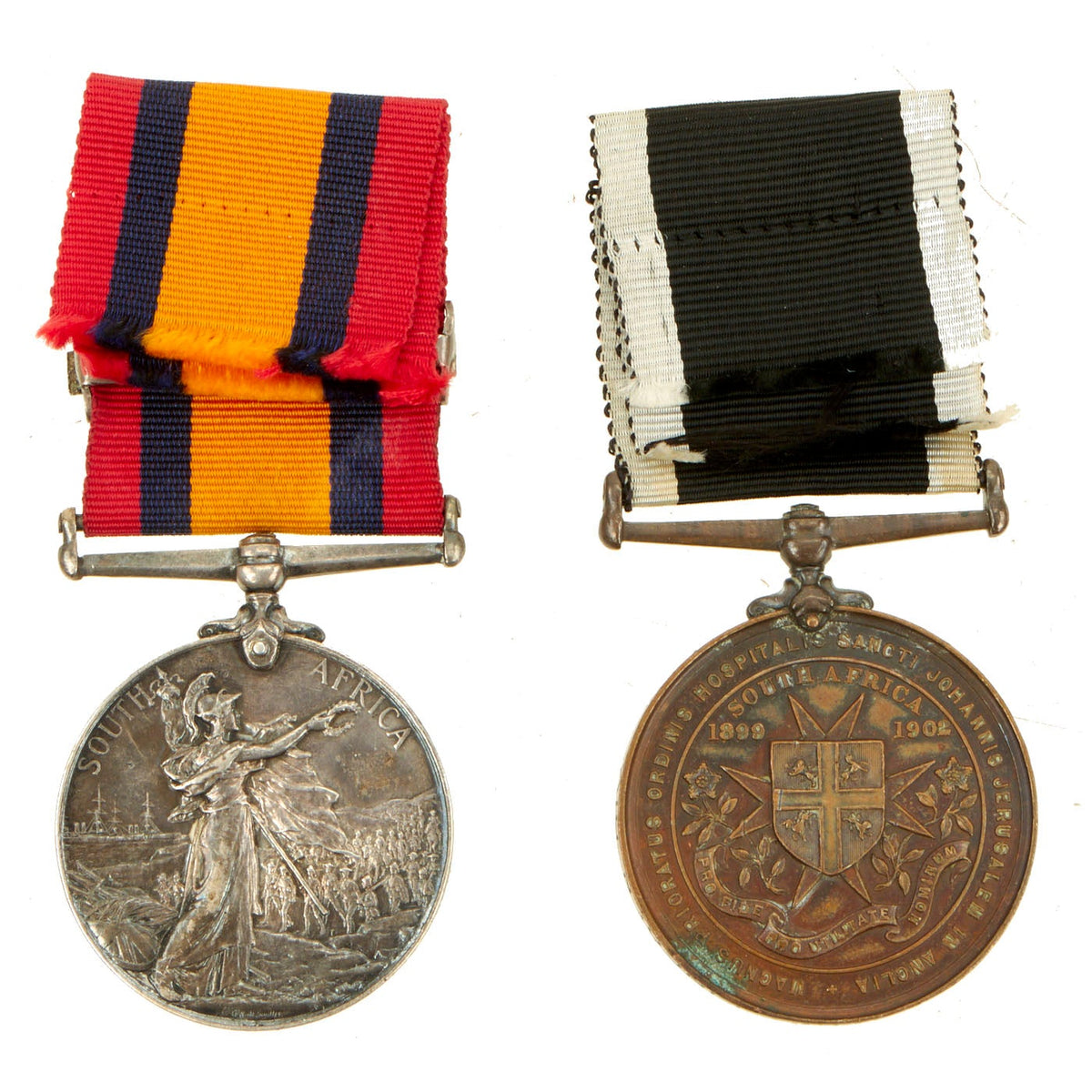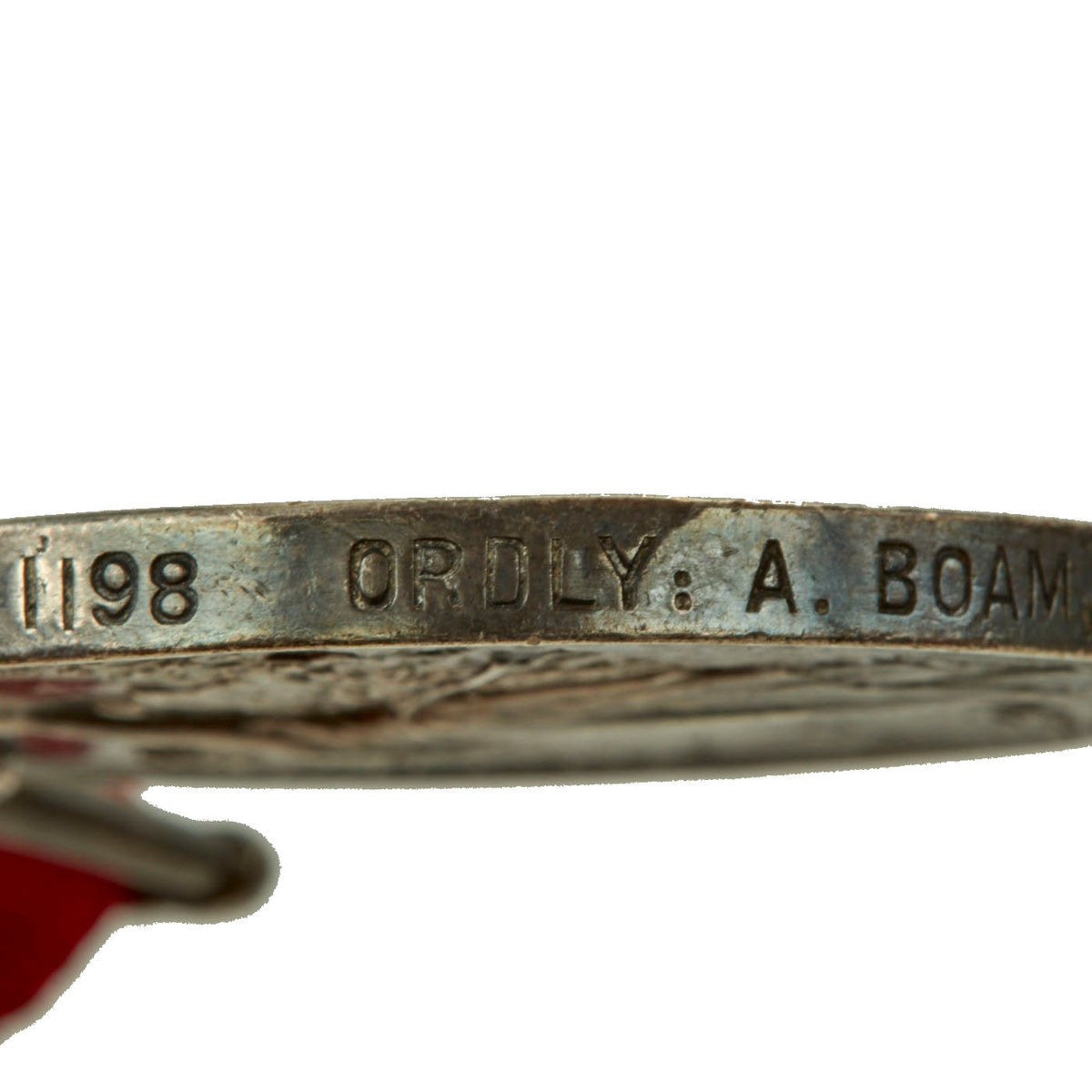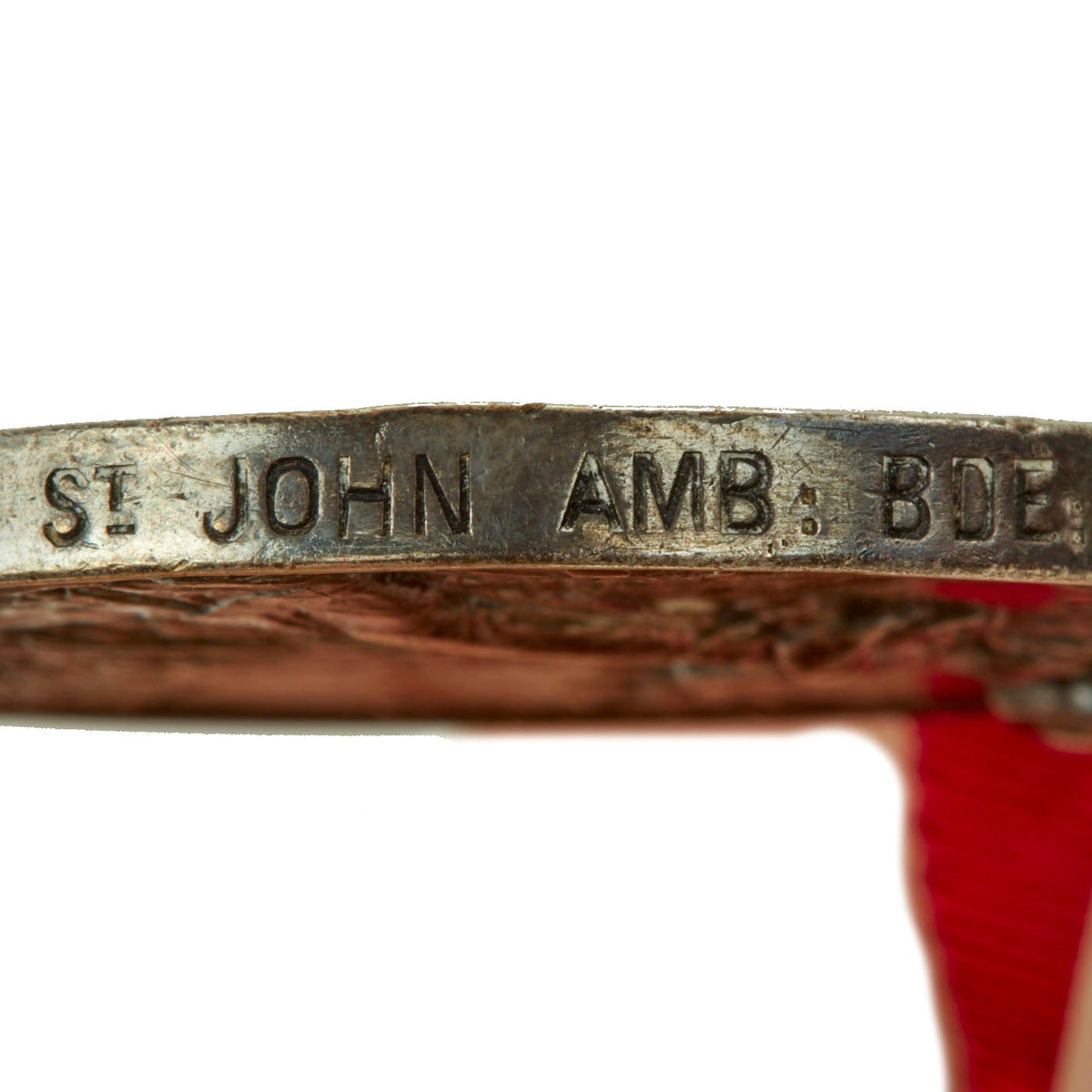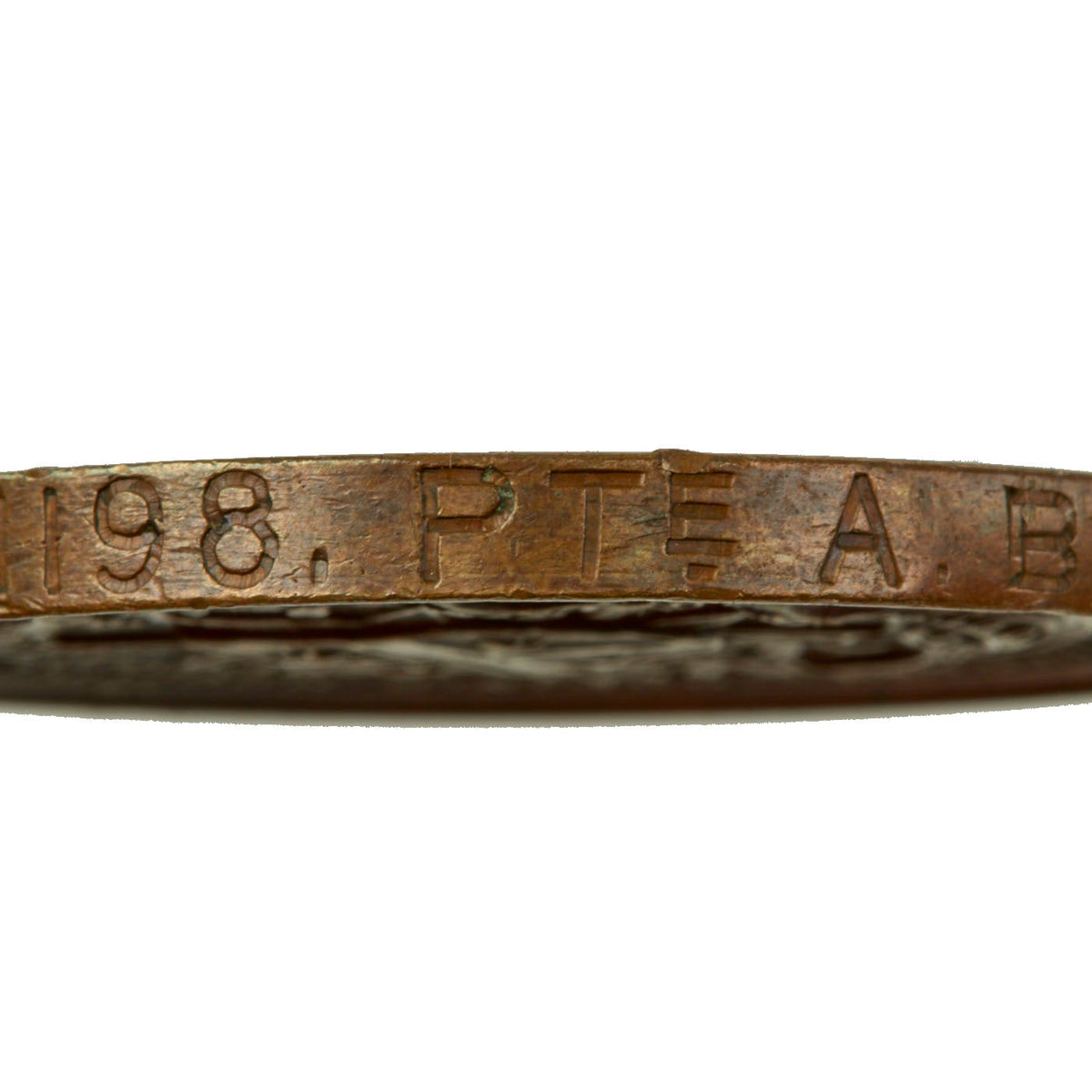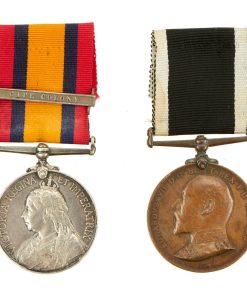Original British Boer War Medal Group – No 5 General Hospital – St. John’s Ambulance Brigade – Engraved Rim – Named Original Items
$ 1.295,00 $ 323,75
Original Set: One Of A Kind: The two medals were awarded to Orderly A. Boam of the St. John’s Ambulance Brigade for service in South Africa during the Boer War (1899-1902).
The first medal is The Queen’s South Africa Medal with a Cape Colony clasp. The medal is a British campaign medal awarded to British and Colonial military personnel, and to civilians employed in an official capacity, who served in the Second Boer War in South Africa. Altogether twenty-six clasps were awarded, to indicate participation in particular actions and campaigns. For service within a state, where no Battle clasp was awarded for a specific action within that state. The “CAPE COLONY” and “NATAL” clasps were not awarded together, with “CAPE COLONY” awarded where a recipient qualified for both.
The Queen’s South Africa Medal is a silver or bronze disk, 38 millimetres (1.5 inches) in diameter. The bronze medal was awarded to non-combatant Indian troops and other non-combatant men of whatever nationality who drew military pay, although some silver medals were awarded to native troops. The obverse shows a crowned and veiled effigy of Queen Victoria, facing left, with the legend “VICTORIA REGINA ET IMPERATRIX” around the upper perimeter. The reverse, designed by G. W. de Saulles, shows Britannia holding the Union Flag in her left hand and a laurel wreath in her right hand. In the right background are troops marching inland from the coast. In the left background are two men-of-war, with Neptune’s Trident and Britannia’s shield on the ground in the foreground. Around the top perimeter are the words “SOUTH AFRICA“. The ribbon is 32 millimeters wide, with a 7 millimeters wide red band and a 4 millimeters wide dark blue band, repeated in reverse order and separated by a 10 millimetres wide orange band.
The recipient’s name and details were impressed on the rim of the medal, with some officer’s medals engraved.
About 1,500 medals were presented unnamed to members of Australian and New Zealand forces during the 1901 tour of those countries by the future King George V. Many were later named locally, either officially at public expense, or privately.
This one is engraved with the following:
The second medal in this group is the St. John Ambulance Brigade Medal. The SJAB men who served in South Africa from 1899-1902 were awarded a bronze medal, which bore the uncrowned head of Edward VII.
The medal is circular, 37mm in diameter and was struck in bronze. The obverse of this medal bears the uncrowned head of King Edward VII and the inscription; ‘EDWARDVS VII. D. G. BRITT. REX. F. D. IND. IMP. The Manufacturer’s name; ‘FUCHS 1901’ is found at the bottom of the medal. The reverse depicts the arms of the Order with the inscription; ‘SOUTH AFRICA’ along with the dates; 1899 and 1902 above and; PRO FIDE PRO UTILATE HOMINIM below. Around the circumference of the medal is the inscription; MAGNUS PRIORATUS ORDINIS HOSPITALIS SANCTI JOHANNIS JERUSALEM IN ANGLIA. The ribbon is 32mm wide and is black in color with a narrow white stripe along either edge. No clasps were authorized for wear on this medal.
The recipient’s details can be found on the medal’s rim. The details of those who also earned the Queen’s South Africa Medal also had the ‘unit details’ of: ‘St John Ambulance Brigade’ impressed on the medal.
The information on this medal is:
Only 1,871 of these medals were awarded for service in South Africa.
Both medals are in excellent condition for how old they are. There is no damage to either and the ribbons are both complete and 100% intact and correct. A pair like this is very desirable, especially a named pair like these! Both come more than ready to display in your 2nd Boer Wars collection!
The Second Boer War – The Second Boer War was fought from 11 October 1899 until 31 May 1902 between the British Empire and the Afrikaans-speaking settlers of two independent Boer republics, the South African Republic (Transvaal Republic) and the Orange Free State.
It ended with a British victory and the annexation of both republics by the British Empire; both would eventually be incorporated into the Union of South Africa, a dominion of the British Empire, in 1910.
The conflict is commonly referred to as The Boer War but is also known as the South African War outside South Africa, the Anglo-Boer War among most South Africans, and in Afrikaans as the Anglo-Boereoorlog or Tweede Vryheidsoorlog (Second War of Liberation or Second Freedom War) or the Engelse oorlog (English War).
The Second Boer War and the earlier, much less well known, First Boer War (December 1880 to March 1881) are collectively known as the Boer Wars.
St. John Ambulance – St John Ambulance, branded as St John in some territories, is a common name used by a number of affiliated organisations in different countries dedicated to the teaching and practice of medical first aid and the provision of ambulance services, all of which derive their origins from the St John Ambulance Association founded in 1877 in the United Kingdom.
Each national group falls within the charge of a Priory or National Council of the Venerable Order of Saint John in which each Priory ranks alongside the others.
In several priories St John Ambulance has commercial sections or subsidiaries operating to generate surplus for charitable activities; these are structured much like other commercial bodies. The membership aspect of St John Ambulance is largely ranked, and members fall into a hierarchical structure of command.
Ranks run from corporals, through sergeants and officers all the way up to high national ranks, but there is significant variation between Priories and it is hard to generalize the structure too much from an international perspective.
Most members of St John Ambulance are not themselves members of the Order, and vice versa, so a major presence of the Order does not dictate a major presence of St John Ambulance. Most notably, the Order of St John is a Christian organization, whereas St John Ambulance is keen to ensure there is no allegiance to any particular religion or denomination, so as to remain available to all.
St John Ambulance works on a more geographical nature than the Order, and has to contend with the differing national laws, medical practices and cultures of countries.
Fast Shipping with Professional Packaging
Thanks to our longstanding association with UPS FedEx DHL, and other major international carriers, we are able to provide a range of shipping options. Our warehouse staff is expertly trained and will wrap your products according to our exact and precise specifications. Prior to shipping, your goods will be thoroughly examined and securely secured. We ship to thousands clients each day across multiple countries. This shows how we're dedicated to be the largest retailer on the internet. Warehouses and distribution centres can be located throughout Europe as well as the USA.
Note: Orders with more than one item will be assigned a processing date depending on the item.
Before shipping before shipping, we'll conduct a thorough inspection of the items you have ordered. Today, the majority of orders will be delivered within 48 hours. The delivery time will be between 3-7 days.
Returns
The stock is dynamic and we cannot completely manage it because multiple stakeholders are involved, including our factory and warehouse. So the actual stock may alter at any time. It's possible that you may not receive your order once the order has been made.
Our policy is valid for a period of 30 days. If you don't receive the product within 30 days, we are not able to issue a refund or an exchange.
You can only return an item if it is unused and in the same state as the day you received it. You must have the item in its original packaging.
Related products
Uncategorized
Uncategorized
Uncategorized
Uncategorized
Uncategorized
Uncategorized
Uncategorized
Australian WWII Owen MK1 Machine Carbine SMG Custom Fabricated Replica with Sling Original Items
Uncategorized
Armored Burgonet Helmet & Polearm from Scottish Castle Leith Hall Circa 1700 Original Items
Uncategorized
Uncategorized
Armoured Fighting Vehicles of the World: AFVs of World War One (Hardcover Book) New Made Items
Uncategorized
Uncategorized
Uncategorized
Uncategorized
Uncategorized
Band of Brothers ORIGINAL GERMAN WWII Le. F.H. 18 10.5cm ARTILLERY PIECE Original Items
Uncategorized
Uncategorized
Angolan Rebel 1970s era 60mm Inert Display Mortar from Angolan Civil War Original Items
Uncategorized
Uncategorized

